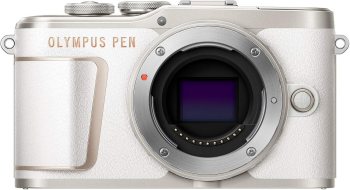- Excellent image quality
- Effective stabilization
- Rugged build
- Stylish design
- Compact and lightweight
- User-friendly
- Complex menu system
- Expensive
- Lower resolution sensor
- Limited manual controls
Olympus OM-D E-M1 Mark III vs Olympus PEN E-PL10
When it comes to Olympus cameras, two models that often come up in conversations among photography enthusiasts are the Olympus OM-D E-M1 Mark III and the Olympus PEN E-PL10. Both of these cameras offer a unique set of features, capabilities, and design philosophies that cater to different types of photographers and shooting styles. In this comparison, we'll delve into the specifics of each camera to help you decide which one might be the best fit for your needs.
Design and Build
The Olympus OM-D E-M1 Mark III is a professional-grade mirrorless camera designed with durability and ergonomics in mind. It features a rugged magnesium alloy body that is weather-sealed, making it suitable for use in harsh environments. The camera has a substantial grip, which provides a comfortable hold even for extended shooting sessions. Weighing approximately 580 grams (including the battery and memory card), it's sturdy but not overly heavy.
On the other hand, the Olympus PEN E-PL10 is a compact and lightweight mirrorless camera aimed at beginners and enthusiasts who value portability. Its body is primarily made of plastic, which keeps the weight down to about 380 grams, including the battery and memory card. The E-PL10 has a sleek design that makes it an excellent choice for casual, everyday photography.
Sensor and Image Quality
Both cameras feature a Micro Four Thirds sensor, but they differ in resolution. The Olympus OM-D E-M1 Mark III comes with a 20.4-megapixel Live MOS sensor, which offers excellent image quality with good dynamic range and low noise levels, even at higher ISO settings. This makes it suitable for professional photography applications where detail and flexibility in post-processing are crucial.
The Olympus PEN E-PL10, on the other hand, sports a 16.1-megapixel Live MOS sensor. While its resolution is lower than that of the E-M1 Mark III, it still delivers high-quality images with vibrant colors and good contrast. The PEN series is known for its appeal to enthusiasts who want excellent image quality without needing the absolute highest resolution.
Autofocus and Speed
The Olympus OM-D E-M1 Mark III boasts an advanced autofocus system with 121 points of cross-type phase detection, offering fast and precise focusing even in challenging conditions. This camera is particularly adept at tracking moving subjects, making it a favorite among sports and wildlife photographers.
In contrast, the Olympus PEN E-PL10 features a 121-point contrast-detection AF system, which, while not as fast or robust as the phase-detection system found in the E-M1 Mark III, still provides quick and accurate focusing for most everyday photography needs. It's well-suited for shooting portraits, landscapes, and street photography.
Video Capabilities
Both cameras are capable of recording high-quality video, but they have some differences in their specifications. The Olympus OM-D E-M1 Mark III can shoot 4K at up to 30 fps (frames per second) with no crop factor, as well as Cinema 4K at 24 fps. It also features advanced stabilization options and professional-grade audio inputs.
The Olympus PEN E-PL10 also supports 4K video recording at up to 30 fps but lacks the cinema mode available on its more advanced counterpart. While it doesn't have all the high-end video features of the E-M1 Mark III, it's still a great choice for casual videography and vlogging.
Conclusion
When choosing between the Olympus OM-D E-M1 Mark III and the Olympus PEN E-PL10, it ultimately comes down to your specific needs as a photographer. If you're a professional or an advanced enthusiast looking for top-tier image quality, robust build, and high-speed autofocus, the Olympus OM-D E-M1 Mark III is undoubtedly the better choice among Olympus cameras.
On the other hand, if portability, ease of use, and a more affordable price point are your priorities, the Olympus PEN E-PL10 offers an excellent balance of features and value. It's ideal for those who want to enjoy the benefits of mirrorless technology without breaking the bank or carrying around a lot of weight.
In summary, both cameras have their unique strengths, catering to different segments within the photography community. Understanding these differences will help you make an informed decision when selecting between these two Olympus cameras.































